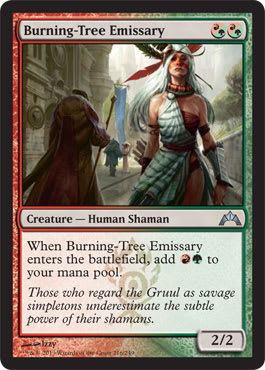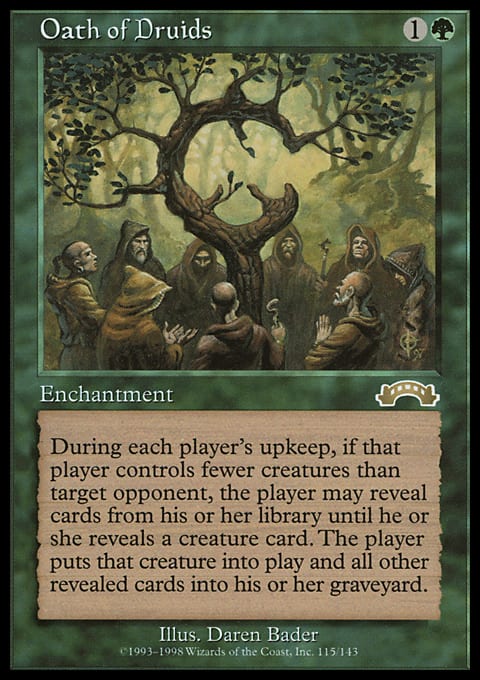If you’re serious about winning big Magic tournaments, one of the first things you need to realize is that you can’t do it alone. If you look at any player who’s made a big splash on the Pro Tour, you’ll see someone who had a strong team to work with: Luis Scott-Vargas, Jon Finkel, Kai Budde, and even the most recent Pro Tour winner Craig Wescoe. The idea of high-level Magic as an individual game dominated by a bunch of lone wolves is completely inaccurate. The kinds of wolves who take down big tournaments are the ones who run in packs.
After two consecutive Pro Tours in which I had a winning record in Draft and a losing record in Constructed, I decided to take a careful look at my process and figure out what’s going on. Despite rumors to the contrary early in my career, I am not merely a Limited specialist. I have two Block Constructed Pro Tour Top 8s, two Top 8s in Extended Pro Tours, and three Grand Prix Top 8s that were in Constructed formats. More recently, I’ve had multiple Top 8s in various Constructed 5Ks in the past few years.
After some reflection, I’ve come to the conclusion that much of it is about the preparation for events since the advent of double-format Pro Tours. Draft prep is fairly straightforward for me and always has been. Put simply: Do as many Drafts as possible, keep trying out stuff until I find a strategy that works for me, and then spend some time perfecting that strategy. Back in “the old days,” this would involve hanging out at the local game store on a nightly basis, constantly drumming up Drafts with as many Pro Tour–qualified players as possible. Now that I don’t live anywhere near a game store with a strong Magic player base, the plan has changed. Fortunately (at least for Draft), my change in circumstance is largely offset by Magic Online. As soon as the relevant set becomes available for drafting online, I cram in as many Drafts as possible, and typically, by the time I step on the plane for the Pro Tour, I feel well-prepared to dominate at a high level.
Preparing for the Constructed portion of the Pro Tour is much more complicated. First of all, relying on Magic Online is typically sheer folly. For several reasons, the decks that dominate online the few days before the Pro Tour when the new set is available are rarely among the best decks at the actual Pro Tour.
- The metagame hasn’t had a chance to develop.
- Magic Online players haven’t had a chance to acquire all of the cards yet.
- Magic Online players are heavily inclined to play decks that are cheaper to build, which has little bearing on the Pro Tour.
- Top pros are reluctant to run their best brews out publically right before the Pro Tour.
- It’s economically overwhelming to build every single deck you want to test online.
What this means is that the most important preparation for the Constructed portion of the Pro Tour is done offline. If you’re preparing by yourself, this is pretty much impossible. You need to design massive quantities of decks and then assemble them. Then, you need to somehow test them solitaire and come up with useful data to make good conclusions and changes. At that point, you’re better off testing online.
So, you need help. While working with other qualified players is ideal—any willing player with some skill can make for a good teammate. While there can easily be a point at which things become too disorganized with a huge team of people, and there can be a sort of too-many-cooks-spoil-the-brew dynamic at some point, this is a much better problem than having too small of a team. When prepping for an important event, having an actual team of people working together is important for two reasons:
- Good, thorough prep involves a massive workload.
- You need multiple viewpoints to cover a format thoroughly.
Take preparing for Pro Tour Dragon’s Maze for example. I started by building ten decks, one for each guild. Think about it. How much time does it take to design, build/proxy, thoroughly playtest, and draw useful conclusions about ten decks? Yet, that was before I worked on any mono-colored decks, three-colored decks, or decks with even more colors. Not only that, but what about multiple possible archetypes within the same guild?
From the time a full spoiler of a new set comes out to the start of the Pro Tour, there’s more work to be done than one or even two people can do comprehensively, especially if the people in question aren’t playing Magic as a full-time job.
Let’s suppose you and your friend are dedicating your entire life to Magic and you’re going to work tirelessly on Constructed from the moment the first spoilers come out and not even stop to find the time to learn the Draft format. There is still the matter of only having two viewpoints represented in your designs and your playtesting. This is an area that especially hurt me in my preparations for Pro Tour Dragon’s Maze.
After I built those eight two-colored decks (I didn’t come up with a good Orzhov deck or a good Dimir deck), I tested them with a fellow Hall of Famer, which was great. Then, I took the most promising decks and tried to see if they would benefit from adding third colors. I continued by testing my best two- and three-colored decks, which turned out to be Bant, Jund, Azorius, Selesnya, Golgari, and Rakdos. I had more deck ideas I would have liked to try, but by that point, I liked Jund, and I really needed to start drafting.
While this was pretty good, and I did go 3–2 with my Jund deck in Constructed on Day 1, it could have been so much better. First of all, the deck-design workload was too much for one person to cover without help. I would have liked to test a mono-red Dynacharge deck, but I didn’t get around to making any mono-colored decks, never mind a four- or five-colored deck. I didn’t even do a good job of covering all the three color options. In addition, Rakdos and Golgari were the only color combinations for which I built more than one quite different deck in the same color combinations. Despite the fact that I designed and built about fifteen different decks, I didn’t cover nearly enough ground. If I were a part of a decently-sized team, we could have covered way more ground, and that alone probably would have ensured me a better deck for the event.
Yet, that doesn’t bother me as much looking back as the lack of additional viewpoints in my process. During preparation for my most successful Constructed Pro Tours, I was part of a strong Team Your Move Games, and we usually had at least three or four premier deck-builders brewing away. Sure, for two of my Constructed Pro Tour Top 8s, I played decks that were of my own design, but even then, I had the benefit of testing against the brilliant designs of others. For example, at Pro Tour Paris in 1997, I was lucky enough to have my teammate Rob Dougherty come up with the Prosperity/Cadaverous Bloom combo deck early in the process, and that directly led me to coming up with an aggressive U/R deck that I played all the way to the Top 4 of the PT, climbing over the corpses of a multitude of Bloom decks in the process. I had a deck that was designed largely to beat them, and I knew from my testing how to play against them. My teammate Dave Humpherys finished ninth in that tournament with a completely different approach than I had—W/U control—but he also benefited from having Bloom to test against. The only member of my team who ended up out of luck was Rob, who abandoned Bloom in favor of mono-black aggro deck at the last minute because he kept losing to Dave and me in testing with Bloom. Looking back at his Day 1 elimination and the fact that the event was won by a Bloom deck, Rob wishes Dave and I hadn’t adapted to beating him so quickly and completely and that he’d stuck with Bloom.
Paris wasn’t the only time my teammates and I ended up playing different decks despite working together. At Houston in 2002, Justin Gary played Oath of Druids, Rob played mono-black Reanimator, and I played The Rock, yet we all made the Top 8, and once there, we didn’t lose a single game except to each other, finishing first, second, and third. Having a good team isn’t necessarily about finding the one really good deck; it’s often just about finding a good deck and having great decks to test against and prepare for.
When it comes to life and Magic, we all have innate biases and prejudices. In my case, I’m super-paranoid about being mana-screwed, color-screwed, or just pushed off the table by a fast deck. Thus, I’m super-reluctant to consider decks with a really high curve or that really stretch the number of colors. This is somewhat ironic since one of the first great Standard decks I designed was known as Five Color Kastle, but it was easier to play five colors back then, with cards such as City of Brass and Birds of Paradise.
The problem I ended up facing with only having my own viewpoint when preparing for Pro Tour Dragon’s Maze was that I was constantly forced to play against decks that I wasn’t prepared for. Most of my opponents were playing slow, three- or four-colored control decks with much better late games than any of the decks in my testing pool. The Azorius deck I tested was super-controlling, but it didn’t have anywhere near the offensive firepower of the three-colored decks at the Pro Tour. I’m confident that if I had a good team to prepare with, someone would have championed a deck or decks like the ones I faced at the actual event. I may not have ended up playing one of them, but I would have been better prepared for them.
While the new Pro Tour format (new to old veterans like me at least) is a perfect example of an event that rewards teamwork, it’s certainly not the only event that benefits having a team. Any Constructed tournament that’s big enough or important enough that you will spend more than a day or two preparing for it is an event that you should have a team working together to get ready for it. I firmly believe it’s the best approach for Pro Tour Qualifiers and Grands Prix, for example. In these days of having a 5K every weekend, it’s probably worth having a team that works together focused on Standard and perhaps Legacy year-round.
So, it’s all well and good to be a terrific brewer and a savvy player, but if you’re going to go really far as a competitive Magic player, you’d better brush up those social skills and start recruiting other players to work together for your common goal of being master wizards. You may be surprised how easy this process can be, especially if you dedicate yourself to being pleasant and hard-working. Even if you’re never the one who comes up with the best deck, you can still be of extreme value to a good team just by assembling a lot of decks and being available to do a lot of testing. Who knows? If you’re as fortunate as I was, perhaps you’ll make some life-long friends in the process.



























